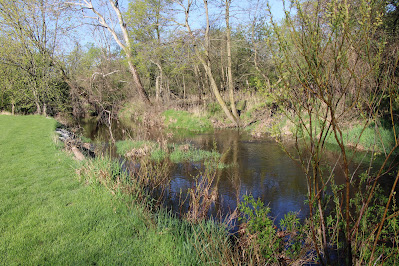The early afternoon weather has temperatures in the low 50’s, cloudy skies and a steady north wind as John Clark, a longtime friend and mentor, and I begin exploring Ithaca Schools’ Outdoor Education Area. While teaching science for 30-some years in Ithaca, John played a vital role in acquiring and developing this property for district students to visit and learn about the natural world. Shortly after entering a woodland of mature Beech and Maple trees, we come upon a familiar wood-decaying fungus called Chicken-of-the-Woods. This edible mushroom can be fried, sautéed, grilled, or baked. It's often compared to the taste and texture of chicken. We then follow a sign to a small pond named in honor of John. Continuing to explore the area, we spot a resting Chipmunk, some Morning Star Sedge and a Sensitive Fern. Up ahead, we observe white blossoms of Silky Dogwood and Maple-leaf Viburnum. On the ground, we spot a 3-inch female flower that fell from a nearby Quaking Aspen tree. These flowers appear as dangling clusters called catkins (stock photo) before the leaves appear. Up ahead, we come upon the base of an invasive Oriental Bittersweet vine. We then observe one of its vines as it tightly wraps itself around the limb of nearby tree. This often girdles and kills these younger trees as the hard woody vine constricts the trunk. The vine will climb anything it can wrap itself around, and it grows very quickly. This makes smaller understory tree species, and shrubs particularly vulnerable to these vines. They continue to climb in search of the canopy while they increase in diameter and put out more leaves, shading out the leaves of the host tree. A single vine can grow as thick as an adult person’s forearm. Further ahead, we spot the rough-looking trunks of a couple of Shagbark Hickory trees. Looking up, we notice some newly forming leaves from one of the trees displaying tiny, multi-colored growths called Hickory Midge Galls. These galls are caused by the feeding and development activities of midge larvae (stock photo). Although infested leaves have abnormal growth and less photosynthetic capabilities, the tree itself is rarely harmed. Heading toward the car, we come upon a decaying log displaying brown-rot. A selective degradation by a certain species of fungi results in a reddish-brown, crumbly appearance of the affected wood. Near the car, we notice a Motherwort plant with its star-shaped leaves. This summer it will produce a stalk of delicate flowers (stock photo).
From a verdant meadow
From the forest ground
From trees on high
Jewels are found
Some bright yellow
Others white and blue
Some mostly red
Others, a purple hue
Colorful displays
To earth they cling
Nature’s gems
Blossoms of spring
D. DeGraaf



